|
Analysis of Accountability: Corporate
Structure and Inter-corporate Responsibilities
The concept of accountability applies when a
person or organization is responsible to another. It is an abstract notion that
can represent
many specific issues, including organization structures, contracts, and
employment.
This analysis begins by introducing the important pattern of Party
(Section 1) - the super-type of person and organization.
The organization structure problem is then used to show the development of the
accountability model. Simple organization structures can be
modeled with Organization Hierarchies (Section 2). When many
hierarchies develop the model becomes too complex, and the
Organization Structure (Section 3) pattern is required. The
combination of the party and organization structure patterns produces Accountability (Section 4). Accountabilities can handle many
relationships between parties: organization structures, patient consent,
contracts for services, employment, and registration with professional bodies.
When accountabilities are used it is valuable to describe what kinds of
accountabilities can be formed and the rules that constrain these
accountabilities.
These rules can be described by instances of types at the Accountability
Knowledge Level (Section 5). This level includes the party type,
which allows parties to be classified and sub-typed with Party Type
Generalizations (Section 6) without changing the model.
Hierarchic Accountability (Section 7) represents those interparty
relationships that do require a strict hierarchy. In this way accountabilities
can be
used for both hierarchic and more complex networks of relationships.
Accountabilities define responsibilities for parties. These responsibilities can
be defined through Operating Scopes (Section 8).
Operating scopes are the clauses of the accountability's contract, rather like
line items on an ongoing order. As these responsibilities accumulate
it can be useful to attach them to a Post (Section 9) rather than
to the person who occupies it.
This analysis is based on many projects: Accountabilities are a common theme.
Original ideas developed with a customer service project
for a utility and an accounting project for a telephone company. The
accountability model was first introduced in the Cosmos project for the
UK National Health Service.
Key Concepts: Party, Accountability
1. Party
Take a look through your address book, and you will see a lot of addresses,
telephone numbers, the odd e-mail address... all linked to something.
Often that something is a person, but once in a while a company shows up. We
call Town Taxi frequently, but there's no particular person we want
to speak to there - We just want to get a cab. A first attempt at modeling the
address book might be Figure 1, but it has a duplication that is painful to an
eye.
Instinctively we look for a generalization of person and company. This type is a
classic case of an unnamed concept - one that everybody knows and uses
but nobody has a name for. We have seen it on countless data models on various
names: person/organization, player, legal entity, and so on.

Figure 1 Initial model of an address book.
This model shows the similar responsibilities of person and organization.
The term we prefer is party. In Figure 2 we define a party as the super-type of a
person or organization. This allows us to have addresses and
phone numbers for departments within companies, or even informal teams.
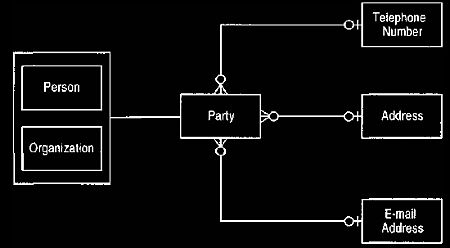
Figure 2 Figure 1 generalized using party.
Party should be used in many situations where person or organization is used.
It is surprising how many things relate to party rather than to person or
organization. You receive and send letters to both people and organizational
units; we make payments to people and organizations; both organizations and
people carry out actions, have bank accounts, file taxes.
These examples are enough to make the abstraction worthwhile.
Example: In the UK National Health Service, the following would be
parties: Dr. John Doe, the renal unit team at St. Mary's Hospital,
St. Mary's Hospital, Parkside District Health Authority, and the Royal College
of Physicians.
2. Organization Hierarchies
Let us consider a generic multinational: Aroma Coffee Makers, Inc. (ACM). It has
operating units, which are divided into regions,
which are divided into divisions which are divided into sales offices. We can
model this simple structure using Figure 3.

Figure 3. Organization structure with explicit levels.
Such a structure is inflexible and not reusable.
This is not a model that we would feel content with, however. If the organization
changes, say regions are taken out to provide a flatter structure, then
we must alter the model. Figure 4 provides a simpler model—one that is easier to
change. The danger with the recursive relationship shown in Figure 4
is that it allows a division to be part of a sales office. We can deal with this
by defining sub-types to correspond with the levels and by putting constraints
on these sub-types. Should the organizational hierarchy change, we would alter
these sub-types and rules. Usually it is easier to change a rule than to change the model structure, so we prefer Figure 4 over Figure 3.

Figure 4 Organization super-type with hierarchic relationship.
The hierarchic association provides the most flexibility. Constraints due to
levels have to be added as rules on the sub-types.
The hierarchic structure provides a certain amount of generality but has some
limitations, including the fact that it only supports a single organizational
hierarchy. Assume that ACM attaches service teams for its major lines of coffee
makers to its sales offices. These teams have a dual reporting structure.
They report to the sales team as well as the service departments for each
product family, which in turn report to product type support units.
Thus the service team for the 2176 high-volume cappuccino maker in Boston (50
cappuccinos a minute) reports to the Boston sales office but also to the
2170 family service center, which reports to the high-volume Italian coffee
division, which reports to the high-volume coffee products service division,
which reports to coffee products service division. (I'm not making this up
entirely!) Faced with this situation we can add a second hierarchy, as shown in
Figure 5.
(More rules would be required, similar to those in Figure 4, but we will leave
the addition of those as an exercise for the reader.) As it stands this approach
works well,
but as more hierarchies appear the structure will become unwieldy.

Figure 5 Two organizational hierarchies.
Sub-types of the organization are not shown. If there are many hierarchies,
this will soon get out of hand.
3. Organization Structure
If it looks like the model will have several
hierarchies, we can use a typed relationship, as shown in Figure 6. We turn the
hierarchic associations into a type and differentiate the hierarchies by using varied instances of the
organization structure type. This would handle the above scenario with two
instances
of the organization structure type: sales organization and service organization.
Additional hierarchies could be added merely by adding more organization
structure types. Again, this abstraction gives us more flexibility for a modest
increase in complexity. For just two hierarchies it would not be worth the
effort,
but for several it would be. Note also that the organization structure has a
time period; this allows us to record changes in the organization structure over
time.
Note further that we have not modeled the organization structure type as an
attribute—a very important factor with type attributes, as we will see later.
Example: The service team for the 2176 high-volume cappuccino maker in Boston
reports to the Boston sales office. We would model this as an organization
structure whose parent is the Boston sales office, subsidiary is the Boston 2176
service team, and organization structure type is line management.
Example: The service team for the 2176 high-volume cappuccino maker in Boston
also reports to the 2170 family service center in the product support structure.
We would model this as a separate organization structure whose parent is the
2170 family service center, subsidiary is the Boston 2176 service team, and
organization structure type is product support.
Simplifying the object structure puts more emphasis on the rules. The rules are
of the form, "If we have an organization structure whose type is sales
organization and whose child is a division, then the parent must be a region."
Note that the rules are expressed by referring to properties of the organization
structure, which implies that the rules should be on the organization structure.
However, this means that extending the system by adding a new organization
structure type would require changing the rules in the organization structure.
Furthermore, the rules would get very unwieldy as the number of organization
structure types increases.

Figure 6 Using a typed relationship.
Each relationship between organizations is defined by an organization
structure type. It is better than explicit associations
if there are many relationships.
The rules can be placed instead on the organization structure type, as shown in
Figure 7. All the rules for a particular organization structure type are held in
one place, and it is easy to add new organization structure types.
Figure 7 does not work well, however, if we change the organization structure
types rarely but add new sub-types of organization frequently. In that
case each addition of a sub-type of organization would cause rule changes. It is
better to place the rules on the sub-types of the organization.
The general point here is to minimize the model changes that occur. Thus we
should place the rules in the most volatile area in such a way that need not
touch other parts of the model.
Modeling Principle: Design a model so that the most frequent modification
of the model causes changes to the least number of types.
4. Accountability
Essentially Figure 7 shows one organization having a relationship with another
for a period of time according to a defined rule. Whenever any statement
is made about organizations, it is always worth considering whether the same
statement can also apply to people. In this case we ask, "Can people have
relationships to organizations or other people for a period of time according to
a defined rule?" This is certainly true, and thus we can, and should, abstract
Figure 7 to apply to a party. As we do this we name the new abstraction an
accountability, as shown in Figure 8.
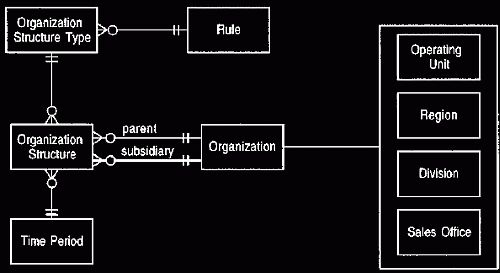
Figure 7 Adding a rule to Figure 6.
The rule enforces constraints such as sales offices reporting to divisions.

Figure 8 Accountability.
Using a party allows accountability to cover a wide range of interparty
responsibilities, including management, employment, and contracts.
Example: John Smith works for ACM. This can be modeled by an
accountability whose commissioner is ACM, responsible party is
John Smith, and accountability type is employment.
Example: John Smith is the manager of the Boston 2176 service team. This
can be modeled as an accountability whose type is manager,
with John Smith responsible to the Boston 2176 service team.
Example: Mark Jones is a member of the Royal College of Physicians. This
can be modeled as an accountability whose type is
professional registration, with Mark Jones responsible to the Royal College of
Physicians.
Example: John Smith gives his consent to Mark Jones to perform an
endoscopy. This can be modeled as an accountability whose type is
patient consent, with Mark Jones responsible to John Smith.
Example: St. Mary's Hospital has a contract with Parkside District Health
Authority to perform endoscopies in 2006/2007. This can be
modeled as an accountability whose type is endoscopy services, with St. Mary's
Hospital responsible to Parkside. The time period on the
accountability would be January 1, 2006, to December 31, 2007. A sub-type of
accountability could provide additional information, such as which
operations were covered and how many should be performed during the contract's
duration.
Modeling Principle: Whenever defining features for a type that has a
super-type, consider whether placing the features on the super-type makes sense.
As the examples indicate, abstracting from organization structure to
accountability introduces a wide range of additional situations that can be
captured by the model. The complexity of the model has not increased, however.
The basic model has the same structure as Figure 7;
the only change is that of using party instead of organization.
5. Accountability Knowledge Level
Complexity has been introduced, however, in that there are many more
accountability types than there would be organization structure types.
The rules for defining accountability types would thus become more complex.
This complexity can be managed by introducing a knowledge level. Using a
knowledge level splits the model into two sections: the operational
and knowledge levels. The operational level consists of accountability, party,
and their interrelationships. The knowledge level consists of
accountability type, party type, and their interrelationships, as shown in
Figure 9.
At the operational level the model records the day to day events of the domain.
At the knowledge level the model records the general rules that
govern this structure. Instances in the knowledge level govern the configuration
of instances in the operational level. In this example
instances of accountability (links between actual parties) are constrained by
the links between accountability type and party type.
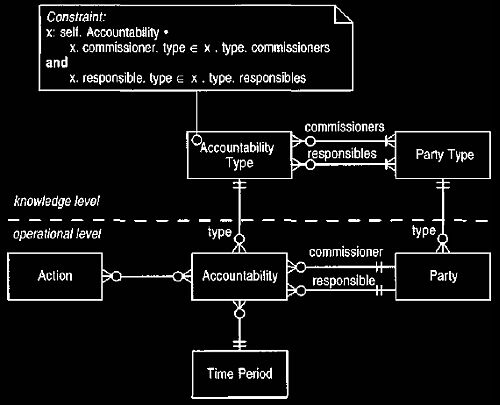
Figure 9 Knowledge and operational levels of accountability.
The knowledge level objects define the legal configurations of operational
level objects.
Accountabilities can only be created between parties according to corresponding
accountability types and party types.
Example: Regions are subdivided into divisions. This is handled by an
accountability type of regional structure whose commissioners
are regions and responsibles are divisions.
Example: Patient consent is defined as an accountability type whose
commissioners are patients and responsibles are doctors.
Note how mapping to the party type replaces sub-typing of the party. This is an
example: of what Odell refers to as a power type,
which occurs when a mapping defines sub-types. The party type is closely linked
to the sub-types of party in that the sub-type region
must have its type as the party type region. Conceptually you can consider the
instance of the party type to be the same object
as the sub-type of party, although this cannot be directly implemented in
mainstream programming languages.
The party type is then a power type of party. Often we need only one of either
the mapping or the sub-typing.
However, if the sub-types have specific behavior and the power type has its own
features, then both sub-types and mapping to the
power type are needed.This reflection between the knowledge and operational
levels is similar but not identical, in that the parent and
subsidiary mappings are multivalued at the knowledge level but single-valued at
the operational level. This is because the operational level
records the actual party for the accountability, while the knowledge level
records the permissible party types for the accountability type.
This use of a multivalued knowledge mapping to show permissible types for a
single-valued operational mapping is a common pattern.
Knowledge and operational levels are a common feature of models, although the
difference between the levels is often not made explicitly.
We make the divisions explicit because we find this helps to clarify our thinking
when modeling. We give lots of examples of operational
and knowledge levels, particularly in
Analysis of Clinical Observations.
Modeling Principle: Explicitly divide a model into operational and
knowledge levels.
A lot of data modelers use the term meta-model to describe the knowledge level.
We are not entirely comfortable with this terminology.
Meta-model can also define the modeling technique. Thus a meta-model includes
concepts such as type, association, sub-typing, and
operation (such as the meta-models of Rational Software's Unified Method). The
knowledge level does not really fall into that category
because it does not describe the notation for the operational level. We thus only
use the term meta-model to describe a model that describes
the language (semantics of notation) for a model.
Accountability represents some pretty heady abstraction and as in any climb we
should stop and take stock before altitude sickness sets in.
Although we have a very simple structure in the object model, a lot of knowledge
is buried in the instances of the knowledge level.
Thus to make this work it is not enough to implement the object model; the
knowledge level must also be instantiated.
Instantiating the knowledge level is effectively configuring the system, which
is a constrained, and thus simpler, form of programming.
It is still programming, however, so you should consider how you are going to
test it.
Rich knowledge levels also affect communication between systems. If two systems
are to communicate, they must not only share the
object model but also have identical knowledge objects (or at least some
equivalence between knowledge levels, as discussed in
In the end it comes down to the question, If the number of accountability types
is large, is it easier to use the structure of Figure 9 or to
extend Figure 5 with one association for each accountability type? The
complexity of the problem cannot be avoided; we can only ask ourselves
which is the simpler model, taking both type structure and knowledge objects
into account.
We need to be careful, as with any typed relationship, that this does not become
a catch-all for every relationship between two parties.
For example, biological parent would not fit as an instance of an accountability
type because neither party is responsible to the other,
nor is there an inherent time period; legal guardian would fit, however.
6. Party Type Generalizations
The model as it stands is quite powerful, but some useful variations will add
even more flexibility. These variations are useful with any model
that uses a knowledge/operational split.
Consider a general practitioner (GP), Dr. Edwards. Using the model shown in
Figure 9, we can consider him to be a GP or a doctor but not both.
Any accountability types that are defined on doctor that would apply also to GP
would have to be copied over. We can use various techniques
to alleviate this problem. One approach is to allow party types to have sub- and
super-types relationships, as shown in Figure 10.
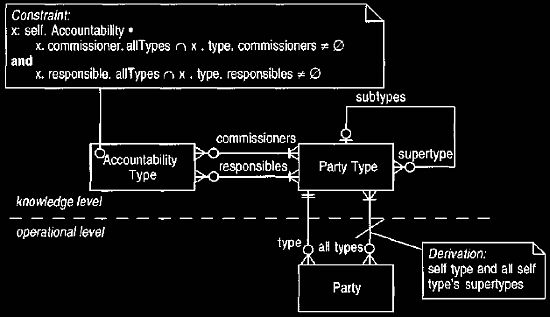
Figure 10 Allowing party types to have sub-and super-types.
Adding generalization to party types makes it easier to define the knowledge
level.
This essentially introduces generalization to party types in a similar way that
generalization works on types. Generalizations cause a change
in the constraint on accountability type, so that both the party's type (from
the type mapping) and the super-types (from the all types mapping)
are taken into account.
Figure 10 provides a single inheritance hierarchy on party type. Multiple
inheritance can be supported by allowing the super-type mapping to be
multivalued. In addition, Figure 10 only supports single classification. This
means that if Dr. Edwards is both a GP and a pediatrician, we can record
that only by creating a special GP/pediatrician party type, with both GP and
pediatrician as super-types. Multiple classification allows party to be
given multiple party types outside of the generalization structure of party
type. This can be done by allowing the type mapping on party to be multivalued.
Much of the discussion about the interrelationships between the knowledge level
and operational level is similar to the relationships between
object and type in a modeling meta-model.
7. Hierarchic Accountability
The flexible structure that accountabilities provide requires more effort to
enforce the constraints of some accountability types.
For example, the organization structure shown in Figure 3 defines a strict
series of levels: operating units are divided into regions,
that are divided into divisions that are divided into sales offices. It is
possible to define an accountability type of regional structure, but
how can we enforce the strict rules of Figure 3?
The first issue is that Figure 3 describes a hierarchic structure. The
accountability models do not have a rule to enforce such a hierarchy.
This can be addressed by providing a sub-type of accountability type with an
additional constraint, as shown in Figure 11. This constraint
acts with the usual constraint on accountability types to enforce the hierarchic
nature of the operational level structure. A similar accountability
type sub-type can be used to enforce a directed acyclic graph structure.
Using Figure 11, we can support the case shown in Figure 3 by a series of
accountability types. An accountability type regional structure level
would have regions responsible to operating units, regional structure
level 2 would have divisions responsible to regions, and so on.
This approach works but would be somewhat clumsy. An alternative is to use a
leveled accountability type, as shown in Figure 12.
In this case there would only be a single regional structure accountability
type. The levels mapping would map to the list of party
types—operating unit, region, division, and sales office. This model makes it
easier to add new leveled accountability types and to modify the
levels in those structures that need it. The hierarchic accountability type
captures the responsibility of the parties forming a hierarchy, the
leveled accountability type captures the responsibility of a fixed sequence of
party types.
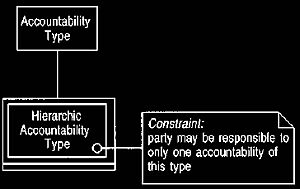
Figure 11. Hierarchic accountability type.
The added constraint means that the parties linked by accountabilities of
this type must form a hierarchy.
The regional structure accountability type would be both leveled and hierarchic.
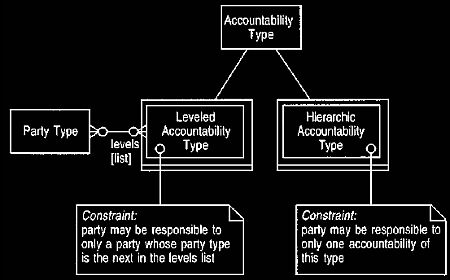
Figure 12. Leveled accountability type.
Leveled accountabilities supports fixed levels such as sales office,
division, region.
The constraints applied on the sub-types act with the constraint defined on
accountability type, following the principles of design by contract.
In the case of the leveled accountability type, the constraint subsumes that of
the super-type, and indeed makes the commissioners and
responsibles mappings superfluous. This thinking leads to a model along the
lines of Figure 13. It is important to note that Figure 12 is not incorrect.
Leveled accountability type is a perfectly good sub-type of accountability type
because the constraint on accountability type will still hold for
leveled accountability type. The commissioners and responsibles mappings will
also continue to hold, although they would be derived from the
levels mapping. We would be inclined to stick with Figure 12. The leveled
accountability type is not always needed, and can easily
be added without violating the model. Figure 12 also has the advantage of making
the knowledge/operational relationship more explicit.

Figure 13. Rebalancing the sub-types of accountability type. A better way of
organizing the accountability type hierarchy.
Accountability, as it stands, provides a valuable way of describing how parties
relate to each other. The type of accountability describes
what kind of relationship they have. There are usually other details, however,
that describe more of the meaning of accountability.
Consider a doctor who might be employed as a liver surgeon to carry out 20 liver
transplants for southeast London in 2002. A diabetic
care team at a hospital might be asked to care for insulin-dependent diabetes
patients in western Massachusetts for the Red Shield HMO
(Health Management Organization).
Such details are the operating scopes of accountability, as shown in Figure 14.
Each operating scope defines some part of consequences
of accountability on the responsible party. It is difficult to enumerate the
attributes of an operating scope in the abstract. Thus we see that
accountability has a number of operating scopes, each of which is some sub-type
that describes the actual characteristics.
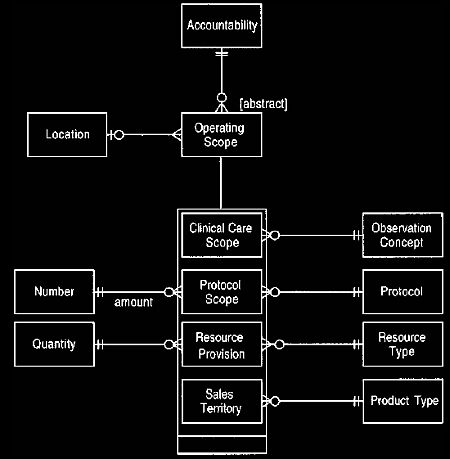
Figure 14. Operating scope.
Operating scopes define the responsibilities that are taken on when an
accountability is created. They can be used for job descriptions.
Example: A liver surgeon who is responsible for 20 liver transplants a
year in southeast London has a protocol scope on
employment accountability with amount of 20, protocol of liver transplant, and
location of southeast London.
Example: A diabetic care team has accountability with Red Shield. This
accountability would have a clinical care scope whose
observation concept is insulin-dependent diabetes and location is western
Massachusetts.
Example: ACM has a contract with Indonesian Coffee Exporters (ICE) for
3000 tons of Java and 2000 tons of Sumatra over
the course of a year. This is described by accountability between ACM and ICE
with a year's time period and two resource provisions:
3000 tons/ year of Java and 2000 tons/year of Sumatra.
Example: John Smith sells the 1100 and 2170 families of high-volume
coffee maker for ACM. He sells both the 1100 and 2170 in
New England and sells the 2170 in New York. He has employment accountability to
ACM with sales territories for 1100 in New England,
2170 in New England, and 2170 in New York.
When using operating scopes for a particular organization, you need to identify
the kinds of operating scopes that exist and the
properties for them. It is very difficult to generalize about operating scopes
in the abstract, but location is a common factor.
The sub-types of operating scope may form an inheritance hierarchy of their own
if there are many of them. In particularly complex cases
you might see an operating scope type placed on the knowledge level to show
which accountability types can have which operating scope types.
(In this case the instances of operating scope type must match the sub-types of
operating scope. Operating scope type
is thus a power type of operating scope.)
9. Post
Often the operating scopes of a person—their responsibilities, including many of
their accountabilities - are defined in advance as that
person's job description. When a person leaves a job, the replacement may
inherit a full set of responsibilities.
These responsibilities are tied to the job rather than the person.
We can deal with this situation by introducing the post as a third sub-type of
party, as shown in Figure 15. Any responsibilities that are
constant to the job, whoever occupies it, are attached to the post. A person
fills a post by having an accountability to the post.
The notion is that a person is responsible for the responsibilities of the post
for the period of time that they are appointed to the post.
Example: Paul Smith is the head of the high-volume product development
team. We can describe this by having a post for the head of the
high-volume product development team. This has a management accountability with
the high-volume product development team (a party).
Paul Smith has a separate accountability (of type appointment) to this post.
Example: The transplant surgeon post at a hospital has in its job
description the requirement to do 50 renal and 20 liver transplants in a year.
This post has an accountability with the hospital and protocol scopes for 50
renal transplants and 20 liver transplants.

Figure 15 Post.
Posts are used when accountabilities and scopes are defined by the post and do
not change when the holder of the post changes.
Appointments to posts are accountabilities.
Posts should not be used all the time. They add significant complexity to the
operational level with their extra level of indirection.
Only use posts when there are significant
responsibilities that are static in a post and people change between posts
reasonably often.
Posts are not necessary in models in which all responsibilities can be attached
to a person.
|